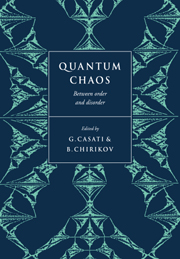Book contents
- Frontmatter
- Contents
- Preface
- Acknowledgments
- Introduction
- Part One Classical chaos and quantum localization
- Part Two Atoms in strong fields
- Part Three Semiclassical approximations
- Part Four Level statistics and random matrix theory
- Characterization of chaotic quantum spectra and universality of level fluctuation laws
- Quantum chaos, localization and band random matrices
- Structural invariance in channel space: a step toward understanding chaotic scattering in quantum mechanics
- Spectral properties of a Fermi accelerating disk
- Spectral properties of systems with dynamical localization
- Unbounded quantum diffusion and fractal spectra
- Microwave studies in irregularly shaped billiards
- Index
Structural invariance in channel space: a step toward understanding chaotic scattering in quantum mechanics
Published online by Cambridge University Press: 07 May 2010
- Frontmatter
- Contents
- Preface
- Acknowledgments
- Introduction
- Part One Classical chaos and quantum localization
- Part Two Atoms in strong fields
- Part Three Semiclassical approximations
- Part Four Level statistics and random matrix theory
- Characterization of chaotic quantum spectra and universality of level fluctuation laws
- Quantum chaos, localization and band random matrices
- Structural invariance in channel space: a step toward understanding chaotic scattering in quantum mechanics
- Spectral properties of a Fermi accelerating disk
- Spectral properties of systems with dynamical localization
- Unbounded quantum diffusion and fractal spectra
- Microwave studies in irregularly shaped billiards
- Index
Summary
Abstract
We define a classical scattering process as a canonical map between the phase spaces of incoming and outgoing channels. Time-reversal invariance is introduced and the iterated scattering map as defined by Jung appears naturally. Using the theory of unitary representations of classical canonical transformations the transition to the quantum problem is achieved in the framework of a semiclassical approximation. Families of canonical scattering maps are defined by canonical transformations on channel space; the invariance properties of these families translate naturally into invariant ensembles of S-matrices that are unique according to Dyson. The concept of structural invariance of an iterated scattering map or Poincaré scattering map is introduced to take into account the generic features of the scattering system on hand. We shall argue that, if this invariance is present in our map, its unitary representation is a characteristic member of the ensemble and thus by way of ergodicity the statistical properties of the corresponding S-matrix are those of the circular ensemble known as COE.
Introduction
The statistical behaviour of scattering processes has been of interest for many years in nuclear physics [1], but recently it has acquired more general importance in the context of quantum manifestations of chaos [2]. In this context one question asked, refers to the statistical distribution of the eigenphases of the S-matrix. Others are of more practical interest, but are also more complicated, such as average fluctuating cross sections and their variances and correlations.
- Type
- Chapter
- Information
- Quantum ChaosBetween Order and Disorder, pp. 577 - 588Publisher: Cambridge University PressPrint publication year: 1995

